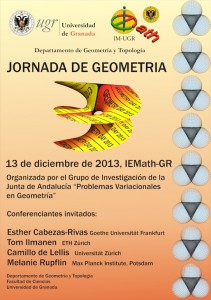As in previous years since 2005, the Research Group Problemas variacionales en Geometría (FQM 325, Junta de Andalucía) organizes the Geometry Day in our University. The 2013 event will be held in the morning of next December 13 at the IEMath-GR (main conference room).
If you would like to attend, please contact Francisco Urbano (furbano(at)ugr.es) with your name, email address and institution.
Schedule:
9:00 – 9:50. Camillo de Lellis (Universität Zürich, Fermat Prize 2013).
Title: Regularity and singularity of area-minimizing currents
Abstract: The Plateau’s problem, named after the Belgian physicist J. Plateau, is a classic in the calculus of variations and regards minimizing the area among all surfaces spanning a given contour. Although Plateau’s original concern were 2-dimensional surfaces in the 3-dimensional space, generations of mathematicians have considered such problem in its generality. A successful existence theory, that of integral currents, was developed by Federer and Fleming in the sixties, following pioneering ideas of De Rham. When dealing with hypersurfaces, the minimizers found in this way are rather regular: the corresponding regularity theory has been the achievement of several mathematicians in the 60es, 70es and 80es (De Giorgi, Fleming, Almgren, Simons, Bombieri, Giusti, Simon among others).
In codimension higher than one, a phenomenon which is absent for hypersurfaces, namely that of branching, causes very serious problems: a famous theorem of Wirtinger and Federer shows that any holomorphic subvariety in $\mathbb{C}^n$ is indeed an area-minimizing current. A celebrated monograph of Almgren solved the issue at the beginning of the 80es, proving that the singular set of a general area-minimizing (integral) current has (real) codimension at least 2. However, his original (typewritten) manuscript was more than 1700 pages long. In a recent series of works with Emanuele Spadaro we have given a substantially shorter and simpler version of Almgren’s theory, building upon large portions of his program but also bringing some new ideas from partial differential equations, metric analysis and metric geometry. In this talk I will try to give a feeling for the difficulties in the proof and how they can be overcome.
Office reservation at IEMath-GR: Office D2, from Dic 12 to 14.
10:00-10:50. Melanie Rupflin (Max Planck Institute, Potsdam).
Title: Teichmüller harmonic map flow
Abstract: Teichmüller harmonic map flow is designed to evolve maps from a closed surface to a general target manifold towards (branched) minimal immersions. Defined as gradient flow of energy considered as a function of both a map and a metric on the domain, the flow enjoys the strong regularity properties known from harmonic map heat flow for as long as there is no degeneration in Teichmüller space but at the same time tries to make the map not only harmonic but also conformal and thus minimal. In this talk we will discuss the definition and properties of the flow and show in particular that global solutions, guaranteed to exist in certain settings, change (or decompose) arbitrary initial data into (a union of) branched minimal immersions, possibly parametrized over surfaces of lower genus. This is joint work with Peter Topping.
Office reservation at IEMath-GR: Office D6, from Dic 12 to 14.
11:00. Coffee break
11:30-12:20. Esther Cabezas-Rivas (Goethe Universität Frankfurt).
Title: A generalization of Gromov’s almost flat manifold theorem
Almost flat manifolds are the solutions of bounded size perturbations of the equation $\mathrm{Sec} = 0$ ($\mathrm{Sec}$ is the sectional curvature). In a celebrated theorem, Gromov proved that the presence of an almost flat metric implies a precise topological description of the underlying manifold.
During this talk we will explain how, under lower sectional curvature bounds, to impose an $L_1$-pinching condition on the curvature is surprisingly rigid, leading indeed to the same conclusion as in Gromov’s theorem under more relaxed curvature conditions (in particular, so weak that we are not allowed to use Ricci flow in the proof). We will describe which alternative techniques lead us to a successful proof, ans this will be sketched in detail. This is a joint work with B. Wilking.
Office reservation at IEMath-GR: Office D5, from Dic 12 to 14.
12:30-13:20. Tom Ilmanen (ETH Zürich).
Title: TBA
Office reservation at IEMath-GR: Office D9, from Dic 12 to 14.



Comments are closed, but trackbacks and pingbacks are open.